Aptitude-Analysis
- Questions not too difficult. Still, if you couldn’t solve all 20 questions accurately, it means (1) you didn’t know the concept/formula/theory (2) you made silly mistake in multiplication/division/addition or subtraction. You can make all excuses about engineer/non-engineer, sci/non-science. But in the end, competition world is cruel, so you’ve to increase practice. The one who runs away from aptitude, usually ends up digging his own grave.
- Like last year, they again asked 20 questions from aptitude. Hence weightage/importance of Aptitude hasn’t changed for UPSC CAPF exam.
- Last year the pattern was: 13 reasoning and 7 (maths+DI). This year, pattern has reversed: 13 (maths+DI) and 7 reasoning
- Like last year, one question on pie chart
- Like last year, one question on dice position.
- Like last year, one question on clock
- unlike last year: no questions from direction sense test or assumption inference.
- like SSC CGL, UPSC has also found new attraction for Geometry. Out of 10 maths questions, 4 came from geometry.
Aptitude-Internal breakup
Solved with help of Mr.Deepak Singh and Mr.Manu Jha.
| Maths | profit loss | 1 |
| basic numeracy/algebra | 2 | |
| Geometry | 4 | |
| ratio-proportion | 1 | |
| time-speed-distance-work | 2 | |
| maths subtotal | 10 | |
| DI | Data interpretation | 3 |
| Reasoning | sequence-series | 1 |
| coding-decoding | 2 | |
| logical venn diagram | 1 | |
| clock-calendar | 1 | |
| Non-Verbal | 2 | |
| reasoning subtotal | 7 | |
| total | overall | 20 |
Correction / if you know even faster methods, do share in comments
overall
| Polity | 14 | Covered. Click me |
| Geography+EnB+Agro | 14+8 | Covered. Click me |
| Economy+IR+PIN | 21+4+2 | Covered. Click me |
| Science | 20 | Click me for Answerkey |
| History | 22 | click me |
| Aptitude | 20 | Given here |
| total | 125 |
Maths
Profit Loss
Q1. selling an article @270, a man loses 10%. If he would sell it @360, his gain percentage is?
- 10
- 15
- 20
- 25
He sold @10% lost=90% of cost price, meaning 270 =90% of cost price. Therefore cost price=270/0.9=Rs.300
His cost price is 300 and if he sells at 360 then profit percentage?
=[(360-300)/300] x 100=60/3=20% answer (C)
Alternatively: 360/(270/0.9) =1.20=>100+20 hence profit is 20%
Basic numeracy/algebra
Q1. 9 mangoes cost as much as 5 oranges. 5 oranges cost as much as 3 apples. 4 apples as much as 9 pineapples and if 3 pineapples cost 48. what will a mango cost?
- 9
- 12
- 18
- 27
Start from reverse: 3 pineapples = 48 meaning 1 pineapple =48/3=16 Rs.
| given | meaning |
| 4 apple=9 pine | 1 apple=9P/4 |
| 5 orange=3apples | 1 orange=3A/5=3*9*P/(5*4)=27P/20 |
| 9 Mangoes=5 oranges | 1 mango=5*orange/9=5*27P/(20*9) |
but we know that 1 pineapple=16, so,
1 Mango=5*27(16)/(20*9)=>12 Rs. Answer B
Method 2
9 mangoes = 5 oranges =3 apples… (1)
4 apples = 9 pineapples …(2)
3 pineapples = Rs. 48 => 9 pineapples = 48 *3 => 4 apples = 48 *3 (from 2)
1 apple = 12*3 => 3 apples =12*3*3 => 9 mangoes = 12*3*3 ( from 1)
Therefore, 1 mango = Rs. 12 .. option (b)
Method 3
Every fruit’s 1st Alphabet has been taken as variable.
- 9M = 5O = 3 A
- 4A=9PA
- 3PA =Rs 48
- 1PA = Rs16
- 9PA = Rs144
- 4A=Rs 144
- 3A=Rs 108
- 9M=Rs 108
- 1M =Rs12 hence answer (B)
Q2. least integer whose multiplication with 588 leads to perfect square is?
- 2
- 3
- 4
- 7
Factors of 588 = 2*2*3*7*7
we already have pairs of twos and pairs of seven. Only three is alone. Hence to make a perfect square, we need to multiply it with 3 =>answer (B)
Ratio
Q1. if the ratio of X:Y=3/4 and ratio of Y:Z=12/13 then ratio of X:Z is
- 13/3
- 1/3
- 4/13
- 9/13
Method 1
|
Method 2
|
Time-Speed-Distance-Work
Q1. If 5 persons can weave 180 mats in 8 days, how many mats can 8 persons weave in 6 days?
- 200
- 192
- 190
- 180
Suppose speed of one man is “m”.
| situation A | situation B | |
| Speed (S) | 5m | 8m |
| time (T) | 8 | 6 |
| distance (D)=speed x time | 160=5m*8 | D=8m*6 |
Since speed x time = distance.
5m x 8=160=>m=4.
Replace this value in column B’s distance=8m x 6= 8*4*6=192 mats. Answer (B)
Q2. Two cars are moving in the same direction with a speed of 45 km/hr and a distance of 10 km separates them. If a car coming from the opposite direction meets these two cars at an interval of 6 minutes, its speed would be:
- 45
- 55
- 65
- 75
Method1: Train concept
Assume the two cars=first and last wagon of one big train. This train is 10km long!
And with respect to this train’s width, the third car is merely a ‘dot’=assume it is a motor cycle.
Rephrasing the question now:
A train of 10km length is moving at a speed of 45kmph. A motorcycle from opposite direction crosses this train in 6 minutes. What is the speed of that motorcycle?
| SPEED | since opposite direction = have to add speeds. Hencefinal speed (S)=speed of train + speed of motorcycle=(45+m) |
| TIME | time taken to finish distance(T)=6 minutes=6/60 hours. |
| DISTANCE | Distance=10 kms (the length of train). |
apply the STD formula
speed x time = distance
(45+m)*(6/60)=10
m=55 kmph answer (B)
Method #2
- Car coming from opposite direction meets first car, after 6 minutes it meets second car.
- In that 6 minutes first car has covered 4.5 km
- As D=s*t = 45 *6/60= 4.5 km
- Remaining 5.5 km(10-4.5 = 5.5) covered by car coming from opposite direction in 6 minutes. Let it’s speed be x km.
- Therefore, 5.5 = x * 6/60 => x = 55 km/hr..option (b)
Geometry
Q1. find area of the shaded portion
- 16-4pie
- 16-pie
- 4-pie
- 4-2pie
Observe the smaller square highlighted in purple color.
Size of that smaller square in purple region=one fourth of the big square.
Size of the pie in that purple region=one fourth of the large circle.
therefore, size of the shaded portion
=[small square minus small pie]
=[1/4 (area of big square) minus 1/4 (area of big circle]
=1/4[42-pie*22] ; important: the diameter of big circle=4 hence radius=2.
=1/4[16-4pie]
=[4-pie]
Hence answer (C)
Q2. Sum of the base and altitude of a triangle is 30cm. What is the maximum possible area of such triangle?
- 100
- 110
- 112.5
- 120
Area of triangle= 1/2x (base x altitude)
hence area will be maximum when base=altitude
since base + altitude=30cm so for both of them to be equal- they’ve to be 15cm each.
Now for a triangle with b=15cm and h=15cm, the area will be
=1/2 x b x h
=1/2 x (15 x 15)
=112.5 hence answer C
Q3. person walks from O to circular path AB, as shown by arrows. If radius=100 meters then what is the total distance walked (approximately)
- 703
- 723
- 743
- 823
The circular path
total degrees=360
he is walking a circle of 360-60 degrees=300 degree.
the circumference of an Arc with 300 degrees
=(300/360)*2pie*radius….eq1
The triangle path
He is walking (OA+OB)…eq2
total distance covered
=eq1+eq2
=(300/360)*2pie*radius+(OA+OB)
=(300/360)*2*3.14*100+(100+100)
=723.33
Hence C is the answer.
Q4. in the following triangle, what is the value of X?
- 51
- 360/7
- 62:6/7
- 49:4/7
Since 4y is an exterior angle hence
4y=x+2y.
x=2y…eq1
And in a triangle, sum of three angles=180 so,
A+B+C=180
x+2y+3y=180
x+5y=180
2y+5y=180 (from eq1 we know x=2y)
7y=180
y=180/7
plug this value back in eq1
x=2y
x=2*180/7=360/7 hence answer (B)
Data interpretation
Q1. A campus poll covering 300 under-graduate students was conducted in order to study the students’ attitude towards a proposed change in rules for hostel accommodation. The students were required to respond as ‘support’, ‘neutral’ or ‘oppose’ with regard to the issue. Find number for support, neutral and oppose respectively
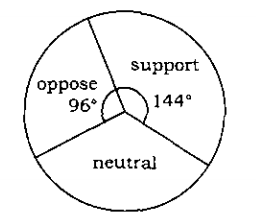
- 150,90,60
- 120,100,80
- 80,100,120
- 60,90,150
shortcut
A circle has total 360 degrees, out of them 96 degrees oppose.
Think in this way – if 96/360 oppose then how many in 300 student oppose?
96/360=Opp/300=>opp=96*300/360=80 students oppose.
So, in the answer (support, neu, opp)= (support,neu,80)
There is only one such pattern- given in Option B. Hence answer B
longcut
so far we found oppose=80. continue finding others
support=144*300/360=120
and finally neutral=total students MINUS (support+oppose)
neutral=300-(80+120)=100
therefore, (support, neu, opp)=120, 100, 80. hence answer (B)
Q2. Expenditure of two families
| expense | family A | family B |
| Misc | 20% | 70% |
| Entertainment | 30% | 20% |
| Food | 50% | 10% |
| Monthly Income Rs | 20,000 | 1 lakh |
Correct statement
- Family A spends as much on misc. as family B spends on entertainment
- The food expense of family B is equal to the total expense of family A
- Family A and B spend equally on food
- Family A and B spend equally on entertainment
It’ll be better if we just convert percentages into absolute rupees.
| expense | family A | family B |
| Misc | 20%=1/5th of 20k=4k | 70%=70k |
| Entertainment | 30%=3/10th of 20k= 6k | 20%=20k |
| Food | 50%=half of 20k=10k | 10%=10k |
| total income | 20,000 | 1 lakh |
now check the statements
|
wrong |
|
wrong |
|
Correct. |
|
wrong |
Hence answer (C)
Q3.In a class,40 students passed in Mathematics, 50% of the students passed in English, 5% of the students failed in Mathematics and English, and 25% of the students passed in both the subjects. What is the ratio of the Number of students passed in English to number of student passed in maths?
- 1:1
- 2:3
- 5:7
- 10:9
Total students=40
Failed in both=5% of 40=2=> n=2
passed in both=25% of 40=10
passed in English=50% of 40=20
Construct Venn diagram
Those passed only in English=20-10=10 students.
What about those passed only in maths?
=total MINUS (passed only in English + passed in both + failed in Both)
=40-(10+10+2)
=18
so how many passed in MAths?
=passed only in MAths (but failed in English) + passed in both subjects
=18+10=28
Ratio: passed in English : passed in Maths=20:28=5:7. Answer (C)
Reasoning
Sequence-Series
Q1. Find the fifth term in this series: BCYX, EFVU, HISR, KLPO
- NOML
- NOLM
- ONML
- ONLM
Pattern: each term is made of two blocks, observe
| BC||YX | BC (move forward by one alphabet)=+D=EFYX (move backward by one alphabet)=-W=UV and flip it=VU | result is second term EF||VU |
On the same pattern
KL||PO
KL + move forward by one alphabet (M)=NO
PO+ move backward by one alphabet (N)=LM and flip it=ML
Hence fifth term will be NO||ML=>answer (A)
Coding decoding
Q1. In a certain code, ‘PLANT’ is written as $@2*c and Yield is written as b64@%. What is the code for Delay?
- b4*2%
- b4@2%
- %42@b
- %4@2b
| P | L | A | N | T |
| $ | @ | 2 | * | c |
and
| Y | I | E | L | D |
| b | 6 | 4 | @ | % |
plug in the values for Delay, using above chart.
| D | E | L | A | Y |
| % | 4 | @ | 2 | b |
Hence answer (D)
Q2. A is coded as 1, B as 3, C as 5 and so on. Which of the following is the numerical value of the word ‘FAZED’ if the numerical value of CABLE is 41?
- 81
- 80
- 79
- 77
A= 1 , B= 3 , C = 5.
It is an Arithmetic progression with common difference 2.
hence pattern is a+(n-1)*d
let’s make table only for the alphabets we need
| A | 1 |
| B | 3 |
| C | 5 |
| D | 7 |
| E | 9 |
| F | 11 |
| L | 12th term=1+(12-1)*2=23 |
| Z | 26th term=1+(26-1)*2=51 |
now let’s check
CABLE
=C+A+B+L+E
=5+1+3+23+9=41 (correct match to question condition.)
now FAZED
=F+A+Z+E+D
=11+1+51+9+7=79 hence answer (C)
Logical Venn Diagram
Q1. Which one among the following diagrams illustrates relationship among animals, cows and horses?
Animals (cows, horses).. option (c)
Clock-Calendar
Q1. through how many degrees does the hour hand in a clock move as the time changes from 3 hours and 12 minutes to 6 hours?
- 105
- 99
- 90
- 84
shortcut
Hour hand is the shorter hand. If it moved from 3PM to 6PM, we can say 90 degrees. Hence at 3.12 minutes to 6PM, it’ll be less than 90 degrees. There is only one option (D) qualifies under this condition, because 84 is less than 90.
Longcut#1 (using hour distance)
Circle has total 360 degrees and a clock has markings for total 12 hours. Therefore, one hour=360/12=30 degrees.
| approach 1 | approach 2 |
now the distance between 3:12 and 6=eq1 minus eq2=180-96=84 degrees. Option D |
|
Longcut#2 (using minute distance)
- in a clock, 3 hours=90 degree and 3 hour=3 x 60 minutes=180 minutes
- therefore, 180 minutes=90 degree=>1 minute =90/180=0.5degree.
- from 3.12PM to 6PM, total minutes are 2 hours + 48 minutes=168 min (from 3 hr 12 mins to 6 hrs = 180 – 12 mins) 168 min = how many degrees ? 168*0.5=84 degree. Hence answer (D)
Non-Verbal
Q1. what will be the next figure in this series?
Black dot is moving from corner to corner. Plus sign and white dot are moving cross to and fro. Whenever two signs coincide it becomes black dot. ..option (a)
Q2. Which one among the following boxes is similar to the box formed from the given sheet of paper (X)?
method1
F & B cant be adjacent sides. A ruled out.
D & A cant be adjacent sides. D ruled out.
E & C are opposite sides , Hence C ruled out.
Hence we’re left with answer (B)
method2
Visualizing the box B,E,F,C are on the same straight line and A,D forms the opposite sides of visualized box. Therefore one possible combination with respective opposite faces is
B <->F, E<->C , A<->D=option (b)
Correction / if you know even faster methods, do share in comments
Courtesy: Mr.Deepak Singh and Mr.Manu Jha for providing valuable inputs.

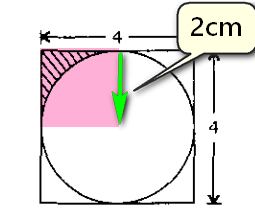

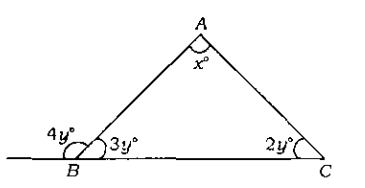


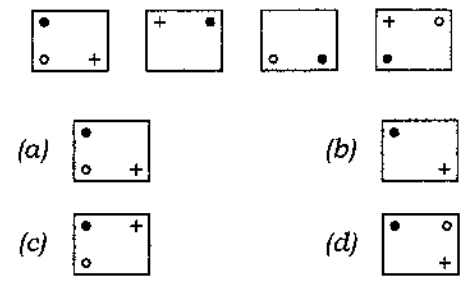
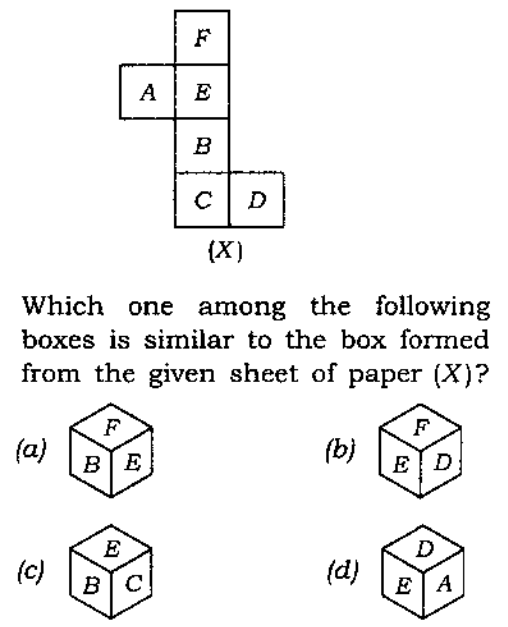

![[Errors/discrepancy] 16 MCQs where UPSC Official Prelims-2020 Answerkey & Coaching classes differ, while 2 MCQs cancelled](https://mrunal.org/wp-content/uploads/2021/11/csp2020-akey-differ-table-500x383.png)
Brother it misplacing in mat . in question there is 180
And in solutions. It’s 160
So that correct as per answer given is 192
So 160 is correct
In a class consisting of 100 students 20 know English and 20 do not know Hindi and 10 know neither English nor Hindi. The number of students knowing both Hindi and English is